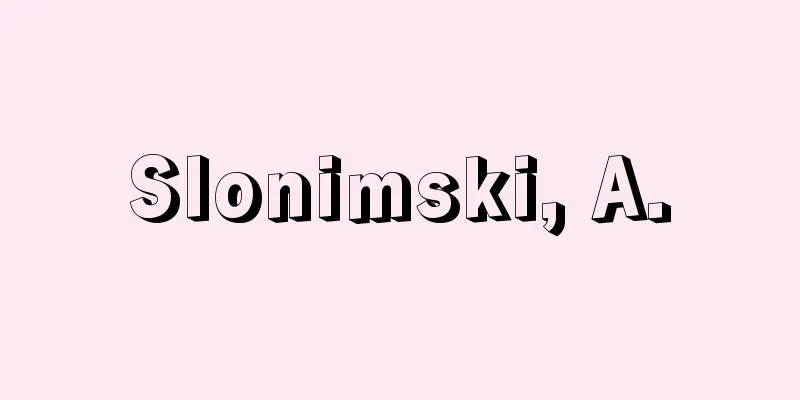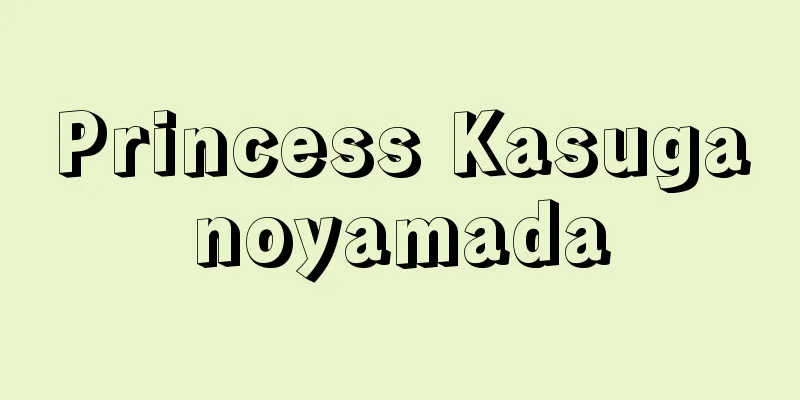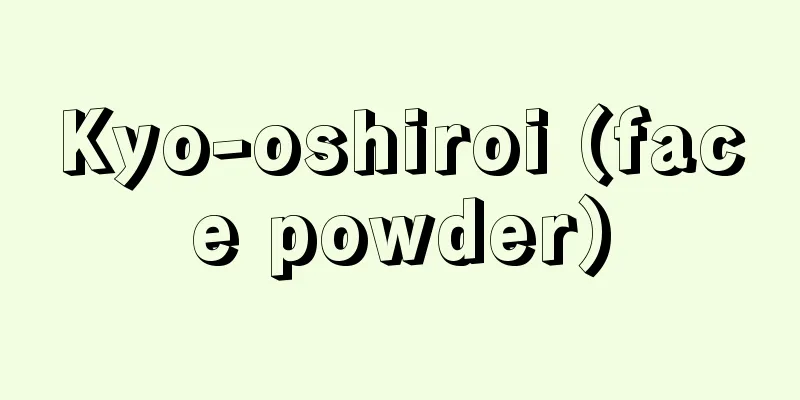Contemporary art - gendai bijutsu (English spelling) contemporary art

|
Usually, contemporary art refers to 20th century art broadly, and art from the post-World War II period onwards narrowly. For a long time, we have conflated these two meanings, in other words, we have treated contemporary art as modern art. However, more than half a century has passed since the Second World War, and we have entered the 21st century. Given the length of time, the post-war period has come to rival the modern art of Impressionism or Post-Impressionism to the pre-war period. In light of this fact, we have now reached a time when we must distinguish to some extent between the period before and after the Second World War. [Shigeo Chiba] Modern and contemporary artIf we use the word "contemporary" only in the sense of "of that era, of the same era, currently," then "contemporary art" always refers to art of the "now" at that time. However, in 20th century art, especially art after World War II, "contemporary art" has come to be used in contrast to "modern art" in addition to the meaning of "now" art. Incidentally, the use of the term contemporary art in contrast to modern art varies depending on the era, country, and of course person. In general history, modernity (in the narrow sense) usually refers to the period after the collapse of feudalism, and in Japan, it refers to the period after the Meiji era. Contemporary art refers to the period after World War II, and in Japan, it refers to the period after the Pacific War. However, as mentioned earlier, in the case of art, contemporary art is usually referred to as 20th century art in the broad sense, and art after World War II in the narrow sense, even though it cannot be defined completely unrelated to these general historical periodizations. A clear change in terminology can be seen before and after World War II. In other words, the term "contemporary art" was never common or widely used before. "Modern art" was usually used, and the word "modern" included the meaning of "now, contemporary" and was entrusted to it. Modernity, as opposed to the preceding early modern period, was precisely the present day for those modern people, and included the claim that it was different from the early modern period. This is most symbolically expressed in Baudelaire's definition of "modernity" and Rimbaud's words, "It must be absolutely modern." Before World War II, modern art from Impressionism and Post-Impressionism onwards also meant contemporary art. In contrast, after the Second World War, as we get closer to the present, a view gradually emerged in which the period from the beginning of the 20th century onwards (specifically the period from Cubism to Dadaism and after), and then Action Painting and Art Informel after the Second World War, were considered to be the "contemporary" period, separate from the "modern" period. Then, from the end of the 1970s onwards, as a result of a growing awareness of the end of modernity, a trend known as "postmodernism" emerged. Underlying this was the desire for a new era and new art, and a sense of stagnation at the very end of modernity. And so we have entered the 21st century in this state of affairs. Since the Second World War, we have certainly sensed a different appearance in the world, in society, in politics, and in ourselves. In terms of art, even though our very words and eyes are still inevitably under the spell of modernity, mass society, consumer society, and information society have greatly changed human sensibility, and a series of works of art that are difficult to call modern in terms of their actual style have appeared one after another, and we sense that art itself is undergoing a major transformation. Although we can still only speak in modern terms, the reality of art has already stepped into a contemporary era that is different from modernity - this realization is probably the basis for the urge that has always made us unable to distinguish "contemporary" from modernity since the Second World War. In 1963, art critic Atsushi Miyagawa formulated this in the words "the contradiction and conflict between modernity as a concept of style and modernity as a concept of value." And it can be said that we are still in a state of contradiction. Art from the 20th century onwards, which stands on the edge of modernity, can be said to have been developed while always carrying a consciousness of postmodernity (after modernity), or more precisely, late modernity (late modernity), but this only became evident in phenomenal terms with the emergence of New Painting or Neo-Expressionism from the end of the 1970s onwards. Since then, although a single movement has no longer become a major epoch-defining movement as in the first half of the 20th century, the consciousness of late modernity has continued to recur like small waves in a variety of styles up to the present day. As modernity itself was questioned, the importance of North America, which had led art after the Second World War, declined relatively toward the end of the 20th century. Instead, firstly, the importance of Europe, which had been trying to form a community after a long journey, is being restored. Secondly, the collapse of the Soviet Union, the end of the Cold War, and changes in Eastern Europe have greatly changed the situation not only in Europe but also in the world. In the field of art, for example, artists from the former Soviet Union and Eastern Europe, such as Ilya Kabakov, are bringing unprecedented stimulation to art around the world. Thirdly, Asian artists, living in America or Europe or based in their own countries, are bringing different ideas and styles to Western modern art, thereby transforming the art situation around the world. In response to these new stimuli and ideas, the art of the 21st century will raise questions of how Western European art will develop, how North American art will recover its energy, and how art and artists from Asia and other non-Western regions will establish their own originality. [Shigeo Chiba] Contemporary Art before World War II = Modern ArtModern art began to stir with the Impressionists and Post-Impressionists Van Gogh, Gauguin, Cézanne, Redon, Seurat, Monet, and others, and in 1905, French painters known as the "Fauves" (Fauves), including Matisse, Derain, Braque, and Rouault, produced compositions using intense primary colors, while around the same time in Germany, the Expressionist movement arose. Painters such as Nolde, Kirchner, and Pechstein of the "Brücke" (Bridge School), Kandinsky, Macke, Marc, and Klee of the "Blue Rider" (Blauer Reiter), as well as Beckmann and Kokoschka, asserted strong emotional expression that was not satisfied with what had come before. Following Expressionism, which was seen mainly in France and Germany, on the one hand, a great river of abstract painting emerged through Cubists such as Picasso, Braque, Gris, and Léger, and on the other hand, Surrealism was born through Dada. Abstract art originated from the end of the 19th century, with numerous attempts to blossom at roughly the same time, including Cubists, Delaunay, Picabia, and others in France, Klee and Kandinsky centered around the Bauhaus in Germany, Mondrian in the Netherlands, and Malevich in Russia and Francis Kupka in the Czech Republic, though at slightly different times. And before the Second World War, it could be said that while internally it contained two contrasting tendencies, geometric abstraction (cold abstraction) and expressive abstraction (hot abstraction), externally it was polar opposite to Surrealism. Surrealism started as a literary movement after Dada, a movement that was imbued with the idea of rejecting art, which arose almost simultaneously in Zurich, Paris, Berlin, Cologne, New York, and other places, and had a great influence on visual arts as well. In terms of style, it included a diversity of works from something close to abstraction to concrete, and generally brought about the expression of a dream world that transcends the human unconscious and consciousness. Dali, Tanguy, Miro, Duchamp, Man Ray, Ernst, Masson, Arp, Giacometti, and de Chirico were active. This is roughly the flow of events before the war, and just as Surrealism and abstract art were side by side, humanity entered the second world war. [Shigeo Chiba] Post-World War II Modern Art = Contemporary ArtIt is not possible to talk about every country or region in the world here, but I will provide an overview dividing it into Europe and America. Europe also differs considerably from country to country and region to region, but for example, France has a long tradition of art, and since Baudelaire, has had a keen awareness of modernity and contemporary art, and today's artists have a global awareness of simultaneity and an innate sensitivity to Renaissance paintings that can be directly felt as being from their own era, so it is not enough to simply distinguish a certain period from then on. If we consider it to be after World War II, the first movement to come to mind is the movement known as Informel or Abstract Expressionism from the 1940s to the 1950s, led by Fautrier, Bors, and Dubuffet, followed by French pop art from the late 1950s, known as Nouveau Réalisme, led by Armand Fernandez Arman (1928-2005), Tinguely, and César Baldaccini (1921-1998). Towards the middle of the 1960s, conceptual art had hardly spread in France, apart from artists such as Daniel Buren (1938- ). Instead, new abstract paintings based on "support and surface" (support and surface) were produced by Louis Cane (1943- ), Claude Viallat (1936- ), and others, while new figurative paintings by Gudmunder Gudmundsson Erró and Valerio Adami (1935- ) began to develop. Germany and Italy were defeated in the Second World War, so it took time for the nations to recover, and artistic progress was delayed. However, in Germany, with Joseph Beuys as the eldest, a conceptual movement in the interaction with objects emerged, which spread to other areas from the 1960s onwards, giving birth to artists such as Klaus Rinke (1939-). Italy also produced some outstanding individual artists, such as Piero Manzoni (1933-1963), Mario Merz (1925-2003), Jannis Kounellis (1936-2017), and Giuseppe Penone (1947-). In the broader post-modern era, the activities of artists such as Gerhard Richter, Anselm Kiefer, and artists from Russia and Eastern Europe such as Kabakov cannot be overlooked. Meanwhile, America went through its infancy, and the paintings of Jackson Pollock in 1940 were the first truly American works, marking the beginning of American contemporary art. This became the movement known as Abstract Expressionism, which subsequently produced many outstanding abstract painters, including de Kooning, Mark Rothko, and Barnett Newman. From the late 1950s, a Neo-Dada or Pop Art movement emerged, led by Robert Rauschenberg, Jasper Johns, Andy Warhol, Claes Oldenberg, and the group Fluxus, which continued to spread widely until the mid-1960s. In the 1960s, a kind of extreme art appeared as a trend in minimal art by Ellsworth Kelly, Kenneth Noland, Donald Judd (1928-1994), Carl Andre, and conceptual art by Joseph Kosuth. Op art, kinetic art, light art, computer art, and other trends were born in response to the advancement of society and the rapid development of technology. Towards the end of the 1970s, as a reaction against minimalism and conceptual art and under the influence of punk culture, a tendency to directly express the expressive impulse also emerged at the same time as in Europe, and was called New Painting, Trans-avant-garde, and Neo-Expressionism. This was followed by neo-geo, simulationism, neo-conceptualism, and media art, which can be said to be a manifestation of the diversification or diffusion phenomenon that would come to be called multiculturalism after the 1990s. Important writers include Jenny Holzer, Cindy Sherman, and Bill Viola. [Shigeo Chiba] Japanese contemporary artIn contrast, the situation of contemporary Japanese art is complicated. Japan has a long tradition that rivals that of Europe, but at the end of the Edo period, it abandoned tradition and began to move towards Westernization and modernization, and is still on that track today. However, it goes without saying that not everything can be unified under Westernization, and traditional and indigenous elements always lurk in the background, lying at the root. In other words, the contradictory state in which the two elements of Westernization and Japanese tradition have been contradictory, conflicting, and mixed together is nothing other than the reality of modern and contemporary Japan. This is the uniqueness of Japanese art. This situation has continued since the Meiji Restoration, but just as American art went through its infancy and only began to realize art that can be said to be uniquely American after World War II, it can be said that American art went through its infancy before the war (which included pioneering movements such as the Taisho avant-garde and Showa avant-garde) and entered the "modern" era after the Pacific War. In other words, the period from the activities of the Gutai Art Association, which began in 1955 and which featured Kanayama Akira (1924-2006), Shiraga Kazuo, Tanaka Atsuko, Motonaga Sadamasa, Murakami Saburo, and Shimamoto Shozo (1928-2013), which has long been highly regarded overseas as a unique movement, to the series of movements around 1960 that were called "anti-art" or "neo-Dada" by Shinohara Ushio (1932-), Miki Tomio, Akasegawa Genpei, Arakawa Shusaku, Nakanishi Natsuyuki, and Kudo Tetsumi, can be considered the starting point of Japanese contemporary art, in the sense that it was the first time that something original was produced in Japanese art. And what is meant by "unique" here does not simply mean that the actual works are novel, but rather that the qualities seen in them that go beyond and go beyond the concepts of painting and sculpture make one feel that they are different from the traditional Western concept of art. This uniqueness of Japanese contemporary art has been further expanded and reproduced since the late 1960s by artists of the Mono-ha movement, such as Lee Ufan (1936-), Suga Kishio, Koshimizu Susumu (1944-), Yoshida Katsuro (1943-1999), Enokura Koji, and Takayama Noboru (1944-), as well as by artists of the 1970s, such as Hori Kosai (1947-), Yamanaka Nobuo (1948-1982), Nomura Hitoshi, Tatsuno Toeko (1950-2014), Nakamura Isao (1948-), Totani Shigeo, and Endo Toshikatsu, and by the next generation, such as Kawamata Tadashi and Nakamura Kazumi. In the 1990s, with the overall transformation and fluidity of Japanese society, works with subcultural sensibilities, at least on the surface, began to stand out, produced by a generation that had grown up in a consumer and information-based society. However, in reality, these works, including these kinds of works, can be seen as an attempt to create something unique and distinctive. [Shigeo Chiba] Contemporary Asian ArtOutside of Japan, there are particularly large movements in East Asia. In China, since the August 5th Art Movement in 1985 and the Tiananmen Square incident in 1989, the state of modern and contemporary art has been changing dramatically due to the activities of cutting-edge artists both at home and abroad, despite the many contradictions that have surrounded it. In addition, in the movement to achieve a so-called soft landing, the art market is gradually becoming more internationalized, first in Europe and America, and then, since the beginning of the 21st century, overseas Chinese capital has been showing interest in these contemporary artists. In South Korea, Nam June Paik returned to the country during the first civilian government of Kim Young-sam (1993-1998), and in the succeeding Kim Dae-jung (1998-2003) exchanges with overseas countries became extremely active, and art has entered a new stage. [Shigeo Chiba] "Modern Art" by Takiguchi Shuzo (1962, Bijutsu Shuppansha)" ▽ "Contemporary Art - After Pollock" by Higashino Yoshiaki (1965, Bijutsu Shuppansha)" ▽ "The Rise and Fall of Postwar Art" by Hariu Ichiro (1979, Tokyo Shoseki)" ▽ "The Collected Works of Miyagawa Jun, 3 volumes (1980-1981, Bijutsu Shuppansha)" ▽ "Primary Color Contemporary Japanese Art 18: Art of Tomorrow" edited by Inui Yoshiaki (1980, Shogakukan)" ▽ "Minimal Art" by Chiba Shigeo (1987, Libroport)" ▽ "Contemporary Art: Paradigm Lost" by Nakamura Keiji (1988, Shoshi Kaze no Bara, Hakuba Shobo)" ▽ "Contemporary Art - After Warhol" edited by Bijutsu Techo Editorial Department (1990, Bijutsu Shuppansha)" ▽ "Rotating Representations - Contemporary Art" by Tani Arata A Post-Postmodern Perspective (1992, Gendai Kikakushitsu) ▽ The Labyrinth of Contemporary Art by V. Bergin, translated by Muroi Hisashi and Sakai Nobuo (1994, Keiso Shobo) ▽ 25 Figures in Contemporary American Art by Kijima Shunsuke (1995, Shueisha) ▽ Japanese Contemporary Art: The 'Continuing Present' of 24 Artists by Sugawara Norio (1995, Maruzen) ▽ The History of Contemporary Art: Painting, Sculpture, Architecture and Photography by H.H. Arnasson, translated by Ueda Takahiro, Kojima Kaoru et al. (1995, Bijutsu Shuppansha) ▽ Contemporary Art: Paradigm Lost 2 by Nakamura Keiji (1997, Suiseisha) ▽ Contemporary Art Speaks: New York 1940-1970 by E. Di Antonio and M. Tuchman, translated by Hayashi Michio (1997, Seidosha) [References] | | | | | |Art | | | | | | | | | | | | | | | | | | | | | | | | | | | | | | | | | |Nam June Paik| | | | | | | | | | | | | |Pop Art| | | | | | | |Motonaga Sadamasa| |Source: Shogakukan Encyclopedia Nipponica About Encyclopedia Nipponica Information | Legend |
|
普通、現代美術といえば、広くは20世紀美術、狭くは第二次世界大戦以降の美術をさす。そして長い間われわれはこの広狭二様の意味をいっしょにして、いいかえれば現代美術=近代美術と考えて、扱ってきた。しかし第二次世界大戦以降半世紀以上が経過して21世紀に入り、時間の長さからいっても、この戦後が、印象派(印象主義)ないし後期印象派(後期印象主義)から戦前までの近代美術と拮抗(きっこう)するものとなってきているいま、われわれはこの事実に即して、第二次世界大戦を境目としてその前後をある程度区別してとらえる時期を迎えているといってよい。 [千葉成夫] 近代美術と現代美術現代ということばを、「その時代の、同じ時代の、現在の」という意味でだけ用いるならば、「現代美術」contemporary artとは、つねにそのときの「今の」美術をさすことばである。しかし、20世紀の美術、とくに第二次世界大戦以後の美術においては、「現代美術」とは、そういう「今の」美術という意味以外に、「近代美術」modern artとの対比において用いられてきている。 ところで、近代美術との対比でいわれる現代美術という語の使い方は、時代によって、国によって、もちろん人によっても違っている。一般史において(狭義の)近代とは普通、封建制崩壊以降をさし、日本では明治以降をさす。現代とは第二次世界大戦以降、日本では太平洋戦争以降をさす。しかし美術においては、この一般史の時代区分とまったく無関係に定義できるものではないとしても、通常、広義では20世紀の美術、狭義では第二次世界大戦以後の美術を現代美術とよんでいることは先に述べた。 第二次世界大戦の前と後では、かなりはっきりした用語上の変化が認められる。つまり、以前は「現代美術」というよび方はけっして一般的でも多用されていたわけでもなかった。普通には「近代美術」が用いられ、そしてその「近代」なる語に「今の、現代の」という意味が含まれ、託されてきたのである。先行した近世に対する近代、それはその近代の人々にとってはまさしく現代であり、近世とは異質だという主張を含めて現代だった。それはボードレールのいう「近代」や、ランボーの「絶対に近代的でなければならぬ」ということばにもっとも象徴的に表されている。第二次世界大戦前にあっては、印象派や後期印象派以降の近代美術はそのまま現代美術をも意味していたといってよい。 これに対して第二次世界大戦後になると、現在に近づくにつれてしだいに、まず20世紀初頭以降(具体的にはキュビスムからダダイズムに至る時期を境目としてそれ以降)を、ついで第二次世界大戦後のアクション・ペインティングやアンフォルメルあたりを境目として、それ以降を「現代」として、「近代」から切り離して考えようという見方が出てくる。ついで1970年代末期以降になると、近代の終焉(しゅうえん)の意識が強まった結果、「ポスト・モダニズム」という思潮が現れてくる。その底流にあるのは、新しい時代と新しい美術に対する希求と、近代最末期の閉塞(へいそく)感にほかならない。そしてそういう状況のまま、21世紀を迎えている。 第二次世界大戦以後われわれは、確かにいままでとは異質の姿を、世界に、社会に、政治に、われわれ自身に、感じ取ってきている。美術でいえば、われわれのことばそのもの、眼そのものが、いまだにいやおうなく近代の呪縛(じゅばく)下にあるにもかかわらず、大衆社会、消費社会、情報化が人間の感性を大きく変え、実際の様式上もはや近代とはよぶことが困難な美術の作品群が次々に登場していて、美術そのものが大きく変貌(へんぼう)してきていることを感じ取っているのである。われわれはいまだ近代のことばをもってしか語れないにもかかわらず、美術の実際はすでに近代とは異質の現代に踏み込んでいる――これが、この実感こそが、第二次世界大戦以後われわれがつねに「現代」を近代から区別せずにはいられないできた衝動の根拠であろう。1963年に美術評論家宮川淳(あつし)はそれを「様式概念としての現代と価値概念としての近代の矛盾・相剋(そうこく)」ということばで定式化した。そしてわれわれは、いまもなお矛盾のなかに置かれているといってよい。 近代の端に位置する20世紀以降の美術は、ある意味ではポスト・モダン(近代の後)、より正確にはレイト・モダン(近代後期)の意識をつねにはらみながら展開されてきたといいうるが、それが現象的にもはっきりするのは、1970年代最末期以降に現れるニュー・ペインティングまたは新表現主義あたりからである。それ以降、20世紀前半期のように一つの運動が一時代を画する大きなものになることはもはやないにしても、レイト・モダンの意識は、多様な様式のもとに、小さな波のように繰り返されて現在に至っている。 近代そのものを問い直すなかで、20世紀最末期になって、第二次世界大戦後の美術を主導してきた北アメリカの比重が相対的に下がってきた。それにかわって、第一に、長い道のりの末に一共同体を形成しようとしてきたヨーロッパの重要性が回復されつつある。第二に、ソビエト連邦崩壊、冷戦の終焉、東欧圏の変化などが、ヨーロッパ地域のみならず世界の情勢を大きく変えている。美術では、たとえばイリヤ・カバコフのように、旧ソビエトや東欧圏の美術家たちが、世界の美術にこれまでにない刺激をもたらしつつあることがあげられる。第三に、アジアの美術家たちがアメリカやヨーロッパに在住しながら、あるいはそれぞれの国を拠点に活動しながら、欧米の近代美術にそれとは別の思想と様式をもち込むことで、世界の美術状況を変容させつつある。 21世紀の美術は、これらの新たな刺激や思想を受けて、西ヨーロッパの美術がどのように展開していくのか、北アメリカの美術がいかにそのエネルギーを回復させていくのか、そして、そのなかでアジアないし非欧米地域の美術と美術家がどのように独創性を確立していくのかが、問われることになる。 [千葉成夫] 第二次世界大戦前の現代美術=近代美術印象派または後期印象派のゴッホ、ゴーギャン、セザンヌ、ルドン、スーラ、モネらをきっかけとして近代美術の胎動が始まり、世紀が変わって1905年には「フォーブ」(野獣派)とよばれたフランスの画家たち、マチス、ドラン、ブラック、ルオーらが激しい原色による画面構成を生み出し、一方、ドイツでもこれに前後して表現主義の運動がおこった。「ブリュッケ」(橋派)のノルデ、キルヒナー、ペヒシュタイン、「青騎士」(ブラウエ・ライター)のカンディンスキー、マッケ、マルク、クレー、さらにはベックマンやココシュカといった画家たちによる、従来のものに満足できない強い感情表出の主張であった。 このフランスとドイツを中心にみられた表現主義に続いては、一方でキュビスムのピカソ、ブラック、グリス、レジェらを経て抽象絵画の大河が現れ、他方ではダダを経てシュルレアリスムが生まれていく。抽象芸術は19世紀末期の後期印象派の画家たちの試みを源とし、フランスではキュビストをはじめとしてドローネー、ピカビアら、ドイツではバウハウスを中心としてクレーやカンディンスキー、オランダではモンドリアン、さらにロシアのマレービチやチェコのフランチシク・クプカなど幾多の試みが、少しずつずれながらもほぼ時を同じくして開花している。 そして第二次世界大戦前の段階では、いわば内部的には幾何学的抽象(冷たい抽象)と表現的な抽象(熱い抽象)の対比的な2傾向を内在させながら、外部的にはシュルレアリスムと対極をなしたということができる。そのシュルレアリスムは、チューリヒ、パリ、ベルリン、ケルン、ニューヨークなど各地でほぼ同時におこったダダという芸術否定の思想をはらんだ運動のあと、初め文学上の運動としておこったものが造形美術にも多くの影響を及ぼし、様式上は、抽象に近いものから具象まで多様性を内包しつつ、総じて人間の無意識や意識を超えた夢の世界の表現をもたらした。ダリ、タンギー、ミロ、デュシャン、マン・レイ、エルンスト、マッソン、アルプ、ジャコメッティ、デ・キリコらが活躍した。以上が戦前のおおよその流れで、シュルレアリスムと抽象芸術が並び立ったところで、人類は二度目の大戦に突入した。 [千葉成夫] 第二次世界大戦後の現代美術=現代美術ここでは、世界中のすべての国なり地域について語ることはできないが、ヨーロッパとアメリカに分けてその概略を述べる。 ヨーロッパも国や地域によってかなり異なっているが、たとえばフランスでは、美術の長い伝統を有するとともに、ボードレール以来、近代性および現代性に対する鋭い自覚をもあわせもっていて、現在の画家たちは世界的な同時性の意識とともにルネサンスの絵画をも直接的に肌で同時代のものと感じうる感性を備えており、単純にいつ以降を現代と区切ったりすればすむ、というものではない。それを第二次世界大戦以降と仮定して考えるならば、1940年代から1950年代にかけてのフォートリエ、ボルス、デュビュッフェらのアンフォルメルとか抽象表現主義とよばれた動向が最初にあげられ、次に1950年代後半からアルマンFernandez Arman(1928―2005)、ティンゲリー、セザールBaldaccini César(1921―1998)らのヌーボー・レアリスムとよばれたフランスのポップ・アートがある。1960年代もなかば近くなると、フランスではコンセプチュアル・アートはダニエル・ビュランDaniel Buren(1938― )らを除いてはほとんど広がらなかったかわりに、「シュポール‐シュルファス」(支持体と表面)を出発点として、ルイ・カンヌLouis Cane(1943― )、クロード・ビアラClaude Viallat(1936― )らの新たな抽象絵画が、他方ではエロGudmunder Gudmundsson Erró、バレリオ・アダミValerio Adami(1935― )らの新しい具象絵画が展開をみせている。 ドイツやイタリアは第二次世界大戦の敗戦国ということで国家自体の立ち直りに時間がかかり、美術上の進展も遅れたが、ドイツではヨーゼフ・ボイスを最年長として、物体との対応にコンセプチュアル的な動向がおこり、1960年代以降各地に広まってゆき、クラウス・リンケKlaus Rinke(1939― )らを生んでいる。また、イタリアでは個々の作家のなかに、ときに優れた存在を生んでいる。ピエロ・マンゾーニPiero Manzoni(1933―1963)、マリオ・メルツMario Merz(1925―2003)、ヤニス・クーネリスJannis Kounellis(1936―2017)、ジュゼッペ・ペノーネGiuseppe Penone(1947― )らである。 また広い意味でのポスト・モダニズム以降では、ゲルハルト・リヒター、アンセルム・キーファーら、またカバコフらロシアや東欧出身の美術家たちの活動も見逃せない。 他方アメリカは、揺籃(ようらん)期を経て、1940年のジャクソン・ポロックの絵画が、初めて真にアメリカ独自といえるものを生み出すとともに、それがアメリカ現代美術の始まりともなった。それは抽象表現主義とよばれる動向となり、その後もデ・クーニング、マーク・ロスコ、バーネット・ニューマンら抽象絵画に優れた画家を輩出している。また1950年代後半からはロバート・ラウシェンバーグ、ジャスパー・ジョーンズ、アンディ・ウォーホル、クレス・オルデンバーグ、グループ「フルクサス」らにより、ネオ・ダダ的ないしポップ・アート的動向がおこり、1960年代なかばまで大きな広がりを示した。1960年代は、一種の芸術の極限化が、エルズワーズ・ケリー、ケネス・ノーランド、ドナルド・ジャッドDonald Judd(1928―1994)、カール・アンドレらによるミニマル・アートや、ジョセフ・コスースらのコンセプチュアル・アートという動向として現れ、また社会の高度化やテクノロジーの急速な発達に見合った動向としてオプ・アート、キネティック・アート、ライト・アート、コンピュータ・アートなども生まれた。1970年代も末期になると、ミニマリズムやコンセプチュアル・アートへの反動やパンク・カルチャーの影響下に、表現衝動を直接にあらわに出す傾向もヨーロッパと同時的に生まれ、ニュー・ペインティング、トランス・アバンギャルド、新表現主義などとよばれた。続いてネオ・ジオ、シミュレーショニズム、ネオ・コンセプチュアリズム、メディア・アートなどが登場するが、それは、1990年代以降にマルチ・カルチュラリズムとよばれることになる、多様化ないし拡散現象の表れといってよい。重要な作家としてはジェニー・ホルツァー、シンディ・シャーマン、ビル・ビオラらがあげられる。 [千葉成夫] 日本の現代美術それに対して、日本の現代美術の状況は複雑である。ヨーロッパに劣らぬ長い伝統をもっているが、幕末を境に、伝統を捨てて西欧化、近代化へと走りだし、いまもなおそのレールの上を走っている。しかしいうまでもなく、西欧化にすべてを一元化できるわけではなく、伝統的、土着的なものはつねに背後に潜み、根底に横たわっている。つまり、西欧化と日本の伝統性という二つの要素が矛盾し相克し混合してきたという、矛盾的状態そのものが日本の近代そして現代の実相にほかならない。これが日本の美術の固有性なのである。 この事態は明治維新以来のものだが、ちょうどアメリカ美術が揺籃期を経て第二次世界大戦後に初めてアメリカ固有のものといえる美術を実現し始めるのと同じように、戦前までの揺籃期(そのなかには大正期アバンギャルド、昭和アバンギャルドといった先駆的動向もみられた)を経て、太平洋戦争後に「現代」を迎えると考えられる。すなわち、独自の動向として、つとに海外でも評価の高い、1955年(昭和30)に始まる金山明(1924―2006)、白髪一雄(しらがかずお)、田中敦子(あつこ)、元永定正(もとながさだまさ)、村上三郎、嶋本(しまもと)昭三(1928―2013)らの「具体美術協会」の活動から、1960年前後の「反芸術」とか「ネオ・ダダ」とかよばれた篠原有司男(しのはらうしお)(1932― )、三木富雄、赤瀬川原平(げんぺい)、荒川修作、中西夏之(なつゆき)、工藤哲巳(くどうてつみ)らの一連の動向にかけての時期が、日本の美術において初めて独自のものを生み出した時期であるという意味で、日本の現代美術の出発の時代であると考えることができる。そして、ここで独自のものという意味は、単に現実の作品が新奇なものであるということではなく、そこにみられる、絵画という概念や彫刻という概念を超え、はみだすような性格が、西欧的な従来の美術の概念とは異質なものを感じさせずにはおかないという意味なのである。 そして、このような日本の現代美術の独自性は、さらに1960年代最末期以降、李禹煥(リウーハン)(1936― )、菅木志雄(すがきしお)、小清水漸(すすむ)(1944― )、吉田克朗(かつろう)(1943―1999)、榎倉(えのくら)康二、高山登(1944― )らの「もの派」の人々の動向や、1970年代の作家、堀浩哉(こうさい)(1947― )、山中信夫(1948―1982)、野村仁(ひとし)、辰野登恵子(たつのとえこ)(1950―2014)、中村功(いさお)(1948― )、戸谷茂雄、遠藤利克らにより、さらに次の世代の川俣正、中村一美らによりいわば拡大再生産されつつある。また1990年代に入ると、日本社会総体の変容、流動化に伴って、消費社会、情報化社会のなかで育ってきた世代によって、少なくとも表層的にはサブカルチャー的感性の作品が目だつようになる。しかしそれは、本当はそういうものをも含めて、独自なもの、固有なものの創出への試みととらえることができる。 [千葉成夫] アジアの現代美術日本以外のアジアでは、とりわけ東アジア地域に大きな動きがみられる。なかでも中国では、1985年の「八五美術運動」以降、天安門事件(1989)を挟んで、さまざまな矛盾を抱えながら、国内外の先鋭的な美術家たちの活動によって、近・現代美術の状況が大きく変わりつつある。また、いわゆるソフト・ランディングを目ざす動きのなかで、美術市場も少しずつ国際化されつつあり、初めはヨーロッパやアメリカ、ついで21世紀に入るころから華僑(かきょう)資本が、それら現代美術家に関心を寄せるようになってきている。また韓国においては、初の文民政権である金泳三(きんえいさん/キムヨンサム)時代(1993~1998)にナム・ジュン・パイク(白南準(ペクナムジュン))が帰国を果たし、次の金大中(きんだいちゅう/キムデジュン)時代(1998~2003)になると海外との交流がきわめて活発になり、美術も新しい段階を迎えている。 [千葉成夫] 『滝口修造著『近代美術』(1962・美術出版社)』▽『東野芳明著『現代美術――ポロック以後』(1965・美術出版社)』▽『針生一郎著『戦後美術盛衰史』(1979・東京書籍)』▽『『宮川淳著作集』全3冊(1980~1981・美術出版社)』▽『乾由明編『原色現代日本の美術18 明日の美術』(1980・小学館)』▽『千葉成夫著『ミニマル・アート』(1987・リブロポート)』▽『中村敬治著『現代美術 パラダイム・ロスト』(1988・書肆風の薔薇・白馬書房)』▽『美術手帖編集部編『現代美術――ウォーホル以後』(1990・美術出版社)』▽『たにあらた著『回転する表象――現代美術 脱ポストモダンの視角』(1992・現代企画室)』▽『V・バーギン著、室井尚・酒井信雄訳『現代美術の迷路』(1994・勁草書房)』▽『木島俊介著『アメリカ現代美術の25人』(1995・集英社)』▽『菅原教夫著『日本の現代美術――24作家の「持続する現在」』(1995・丸善)』▽『H・H・アーナスン著、上田高弘・児島薫他訳『現代美術の歴史――絵画 彫刻 建築 写真』(1995・美術出版社)』▽『中村敬治著『現代美術 パラダイム・ロスト2』(1997・水声社)』▽『E・ディ・アントニオ、M・タックマン著、林道郎訳『現代美術は語る――ニューヨーク・1940―1970』(1997・青土社)』 [参照項目] | | | | | | | | | | | | | | | | | | | | | | | | | | | | | | | | | | | | | | | | | | | | | | | | | | | | | | | | | | | | | | | | | | | |出典 小学館 日本大百科全書(ニッポニカ)日本大百科全書(ニッポニカ)について 情報 | 凡例 |
Recommend
Sarumaru Dayu - Sarumaru Dayu
Year of birth: Year of birth and death unknown. A ...
Michaelmas
… [Masaaki Kubo] [Early Modern Period] European a...
Jackson's chameleon
A lizard of the Chamaeleonidae family in the repti...
Paper adhesive tape - Kaminenchakuteup
…Used for adhesive labels, adhesive tapes, etc. A...
Casanova, PG - Casanova
…An economist on par with Frank is Theotonio Dos ...
Silver-leafed lily - Silver-leafed lily
...In Japan, deciduous or semi-evergreen shrubs s...
Seal material - Inzai
〘Noun〙 Materials used to make seals. Wood, stone, ...
Attar (Pharmacy) - Attar
…These shops were called ṣaydalānī, which came fr...
Takanori Kyogoku
1858-1928 A member of the aristocracy from the Me...
Mure [village] - Mure
A village in Kamiminochi County in northern Nagano...
Gold-dusted copper
...Amalgam is made by mixing gold or silver with ...
Euhemerism - Euhemerism
…It was the beginning of allegorical interpretati...
Ampere - Ampere (English spelling)
It is the unit of electric current in the Interna...
Soya Main Line
The name of the Hokkaido Railway Company's tr...
Akiko Kanda
...To achieve this, it was necessary to develop n...


![Osaki [town] - Osaki](/upload/images/67cb15611c26e.webp)






